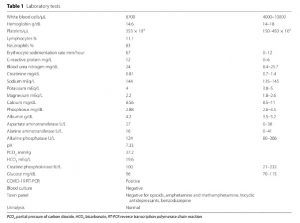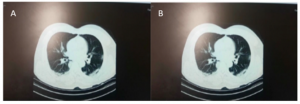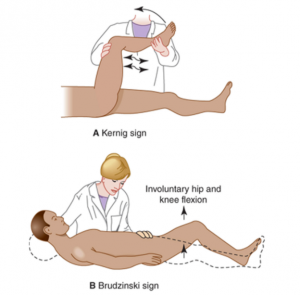This post is adapted for the Health & Medical Case Studies created by the Master of Medical Biotechnology program of the University of Windsor. This work is licensed under a Creative Commons Attribution-NonCommercial (CC BY-NC-ND) 4.0 International License.
33 Case 3-2021: A 53-year-old male with headache and bizarre behavior
Presentation of COVID-19 infection with bizarre behavior and encephalopathy: a case report. Journal Of Medical Case Reports, 15(1). 2021. https://doi.org/10.1186/s13256-021-02851-0
Teimouri-Jervekani, Z., & Salmasi, M.
Case Summary 1
A 53-year-old man presented to the emergency department with symptoms of severe headache and bizarre behavior. Symptom onset occurred 2 weeks before admission with fever and myalgia. The fever lasted 3 days, and then cough and dyspnea appeared, the patient experienced some episodes of severe generalized headache which became progressively worse, and on the day of his admission, he exhibited bizarre behavior with dysarthria (slurring) and for example, he undressed, removing his shirt and trousers, in front of his family and also tried to urinate in the room. He had no specific family or social history. On physical exam, except for dysarthria, he had normal vital signs, no sign of hypoxia, and a normal neurological exam. The patient was alert and oriented to time, place, and person. No neck stiffness, Kernig’s sign, or Brudzinski’s sign was detected. Routine laboratory tests and chest and brain computed tomography (CT) were performed. Laboratory test results were normal except for raised ESR and c-reactive protein. Chest CT revealed bilateral peripheral ground-glass opacities suggestive of COVID-19 infection and then the RT-PCR for COVID-19 came out positive. The patient was then treated accordingly.
Learning Objectives
- Identify atypical presentations of COVID-19 and how standard diagnostic practices for COVID-19 should be inclusive of neurological assessments.
- Investigate and understand the neurological symptoms unique to COVID-19 patients.
- Discuss the lab and medical imaging investigations for atypical COVID-19 cases.
Clinical History 1
- Age: 53 years old
- Sex: Male
- Ethnicity: Iranian
Medical History 1
- Nothing significant.
Drug History 1
- Not applicable.
Symptoms 1
- Severe headache and bizarre behavior (during admission, he undressed, removing his shirt and trousers, in front of his family and also tried to urinate in the room.)
- History of fever and myalgia for 3days which was followed by cough, dyspnea and progressive headaches.
- Dysarthria for 1 day.
Examinations (Clinical Assays/Tests/Imaging) 1
Physical Examination 1
- General appearance: Dysarthria present, but the patient was alert and oriented to time, place, and person.
- Vital signs: Pulse, BP, respiratory rate was normal.
- Neurological examination: Normal, no neck stiffness, Kernig’s sign, or Brudzinski’s sign was detected.
Laboratory Investigations 1
- The lab investigations revealed high ESR, high c-reactive protein along with positive RT-PCR for COVID 19.

Chest Computed Tomography (CT) Scan 1
- Chest CT revealed bilateral peripheral ground-glass opacities suggestive of COVID-19 infection.

Brain MRI 1
- Due to normal brain CT results, brain magnetic resonance imaging (MRI) was performed to evaluate the cause of dysarthria and bizarre behavior. The brain MRI results were normal.

Figure 2: Brain magnetic resonance imaging with diffusion‑weighted imaging.1
Question & Answers Leading to Diagnosis:
Question 1: Based on the clinical history of disease progression and physical examinations of the patient, which disease can we suspect initially and why?
Question 2: What investigations should we plan to confirm and understand the diagnosis?
Question 3: How can we correlate the neurological symptoms with COVID-19 disease?
Question 4: What are the atypical presentations of COVID-19 disease?
** For answers please check the next chapter.
Medical terminology/Abbreviations:
- Myalgia – Myalgia describes muscle aches and pain, which can involve ligaments, tendons, and fascia, the soft tissues that connect muscles, bones, and organs. Injuries, trauma, overuse, tension, certain drugs, and illnesses can all bring about myalgia.3
- Dysarthria – Dysarthria is a motor speech disorder in which the muscles that are used to produce speech are damaged, paralyzed, or weakened. The person with dysarthria cannot control their tongue or voice box and may slur words.4
- Kernig’s sign – Kernig’s sign is one of the physically demonstrable symptoms of meningitis. Severe stiffness of the hamstrings causes an inability to straighten the leg when the hip is flexed to 90 degrees. (Figure 3) It is used to diagnose meningitis.5

- Brudzinski’s sign – Brudzinski’s sign is one of the physically demonstrable symptoms of meningitis. Severe neck stiffness causes a patient’s hips and knees to flex when the neck is flexed. (Figure 3) It is used to diagnose meningitis.7
- Ground-glass opacities – According to Dr. Cortopassi, Ground glass opacities are a pattern that can be seen when the lungs are sick, while normal lung CT scans appear black, an abnormal chest CT with GGOs will show lighter-colored or gray patches. Those lighter patches don’t completely obscure the other structures in the lungs. There is haziness seen overlying an area of the lung, but the underlying structures of the lung (airways, blood vessels, lung tissue) can still be identified. It resembles ground glass or glass that is still transparent but has a matte finish.8
-
- GGOs aren’t specific to COVID-19 and can be seen in so many different settings. GGOs in chest CT scans can also indicate congestive heart failure, inflammatory interstitial lung diseases, and diffuse alveolar hemorrhage (bleeding into the airspaces of the lungs), among other issues. But one of the most common diagnoses for GGOs is viral pneumonias, most often caused by respiratory syncytial virus (RSV), cytomegalovirus, herpes simplex virus, and coronavirus.8
- In terms of COVID-19, Dr. Cortopassi explains GGOs on a CT scan are indicative of COVID-19-related pneumonia, or lung inflammation caused by the viral infection.8
- A study published in the journal Radiology found that, among 51 Chinese patients with confirmed COVID-19 pneumonia, GGOs showed up in the chest CT scans of 77% of patients. And original research from scientists in China, also published in Radiology, found that CT scans were able to find 97% of COVID-19 infections overall, while blood tests were only able to correctly identify 59% of cases.8
References
- Teimouri-Jervekani, Z., Salmasi, M. Presentation of COVID-19 infection with bizarre behavior and encephalopathy: a case report. J Med Case Reports 15, 220 (2021). https://doi.org/10.1186/s13256-021-02851-0
- Day, M. (2020). Covid-19: four fifths of cases are asymptomatic, China figures indicate. BMJ, m1375. https://doi.org/10.1136/bmj.m1375
- Myalgia. (2021). Retrieved 11 June 2021, from https://www.hopkinsmedicine.org/health/conditions-and-diseases/myalgia.
- Dysarthria & Speech: Symptoms, Causes, Treatments. Cleveland Clinic. (2021). Retrieved 11 June 2021, from https://my.clevelandclinic.org/health/diseases/17653-dysarthria.
- Kernig’s Sign. Physiopedia. (2021). Retrieved 11 June 2021, from https://www.physio-pedia.com/Kernig%27s_Sign.
- Kernig sign, Brudzinski sign, how to perform Kernig and Brudzinski test. Health Jade. (2021). Retrieved 11 June 2021, from https://healthjade.net/kernig-sign/.
- Brudzinski’s Sign. Physiopedia. (2021). Retrieved 11 June 2021, from https://www.physio-pedia.com/Brudzinski%E2%80%99s_Sign.
- How Lung Scans Can Detect Coronavirus in Some Patients. Health.com. (2021). Retrieved 11 June 2021, from https://www.health.com/condition/infectious-diseases/coronavirus/ground-glass-opacities-covid-19.
Creative Commons License
Myalgia describes muscle aches and pain, which can involve ligaments, tendons, and fascia, the soft tissues that connect muscles, bones, and organs.
Dysarthria is a motor speech disorder in which the muscles that are used to produce speech are damaged, paralyzed, or weakened. The person with dysarthria cannot control their tongue or voice box and may slur words.
Kernig's sign is one of the physically demonstrable symptoms of meningitis. Severe stiffness of the hamstrings causes an inability to straighten the leg when the hip is flexed to 90 degrees. (Figure 3) It is used to diagnose meningitis.
Brudzinski's sign is one of the physically demonstrable symptoms of meningitis. Severe neck stiffness causes a patient's hips and knees to flex when the neck is flexed. (Figure 3) It is used to diagnose meningitis.


